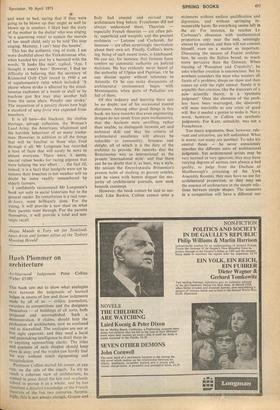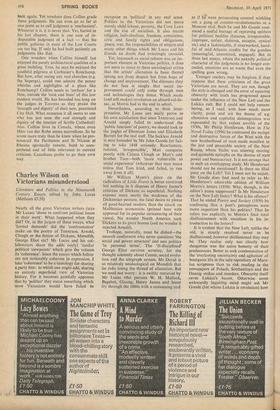Hueh Plommer on architecture
Architectural Judgement Peter Collins (Faber £3.00)
This book sets out to show what analogies exist between the judgments of learned Judges in courts of law and those judgments made by all of us — critics, journalists, awarders in competitions and the designers themselves — of buildings of all sorts, both Projected and accomplished. Such a demonstration, it claims, should help the Profession of architecture, now so confused and so discredited. The analogies are not at first sight apparent; and they need a lucid and painstaking intelligence to distil them in- to anything approaching clarity. The titles and contents of each chapter should keep dose in step; and the reader can hardly find his way without much signposting and recapitulation.
Professor Collins started his career, at any rate, on the side of the angels. To try to reach a coherent view of architecture, he studied in great detail the last real academic school to pursue it as a whole; and he has therefore a detailed knowledge of the French theorists of the last two centuries. Surpris- ingly, this is not always enough. G:eece; and Italy had created and revived true architecture long before. Frenchmen did not always understand them. Theorists especially French theorists — are often pet- ty, superficial and waspish; and the greatest architects — Lutyens and Cockerell, for instance — are often surprisingly inarticulate about their own art. Finally, Collins's learn- ing, being of such recent times, is hidebound. He can say, for instance, that forensic fame confers no automatic authority on judicial decisions. He has evidently never heard of the authority of Ulpian and Papinian. Or he can discuss equity without reference to Aristotle. Or he can make discussions of architectural environment begin with Montesquieu, when parts of Palladius are full of them.
Of this industry and learning there can be no doubt; nor of his occasional mental sharpness. Among other good things in this book, we have remarks that even engineering designs do not result from pure mathematics, that the Ancients were unwilling, rather than unable, to distinguish between,art and technical skill and that the criteria of architectural excellence will always be reducible to commodity, firmness and delight, all of which it is the duty of the architect to provide. He remarks that the Renaissance was as international' as the present 'international style'. and that there can be no doubt that it, at least, was a style. He notices the Encyclopaedia Britannica's present habit of slashing its gravest articles, and he views with honest disgust the ma- jority of architectural journals, now sunk beneath contempt.
However. the book cannot be said to suc- ceed. Like Ruskin, Collins cannot utter a statement without endless qualification and digression, and without springing in- numerable hares. So everything seems left in the air. For instance, he reaches Le Corbusier's obsession with mathematical proportion only near the end, seemingly almost by accident, and then will not commit himself, even on a matter so important. Discussing the success of Fascist architec- ture, he omits the Italian brand, so much more pervasive than the German. When treating of 'Precedent and Creativity', he asks whether creation is unconscious. But he nowhere considers the man who masters all facets of a problem, sleeps on them and then comes up with the right answer. Surely it is arguable that creation, like the discovery of a new scientific theory, is a 'synthetic judgment'. Once the elements of the prob- lem have been rearranged, the discovery will seem inevitable to any critic of good will. But it needed a genius to make it. Not a word, however, in Collins on synthetic judgments. For Kant, unluckily, was not a Frenchman.
Too many arguments, then, however, rele- vant and attractive, are left unfinished. What is worse, too many are jumbled. To take his central thesis — he never consciously specifies the different sorts of architectural judgment. Yet architectural artists may be very learned or very ignorant, they may have varying degrees of animus (not always a bad quality, to judge from the Duchess of Marlborough's criticising of the York Assembly Rooms), they may have no use for architectural proportion, or they may see the essence of architecture in the simple rela- tions between simple shapes. The assessors in a competition will have a different out- look again. Yet nowhere does Collins grade these judgments. He can even go so far at one point as to call judgment a 'mechanism'. Whatever it is, it is never that. Yet, buried in his last chapter, there is one case of in- disputable judgment of a fact — that the public galleries in most of the Law Courts are too big. If only he had built patiently on judgments like that.
One wonders when Collins himself last enjoyed the purely architectural qualities of a great building. True, he says he enjoyed the youthful pilgrims at Corbusier's Ronchamp. But how, after seeing any real churches (e.g. the Superga), could one admire the penny whistles and nightlights of a place like Ronchamp? Collins needs to `surface' for a time, outside the 'mist and hum' of this low modern world. He has brooded too long on the judges in Toronto as they praise the `strength and dignity' of their new, premiated City Hall. What nonsense it all seems to one who has just seen the real strength and dignity of the interior of Scrille Cathedral! Alas. Collins lives in Canada, where even Mies van der Rohe seems marvellous. So he wrote more truly than he knew when he pro- nounced the Parthenon and St Nicaise at Rheims spiritually remote, hard to com- prehend and of little relevance to current criticism. Canadians prefer to go their own way.











































 Previous page
Previous page